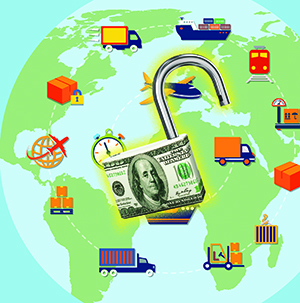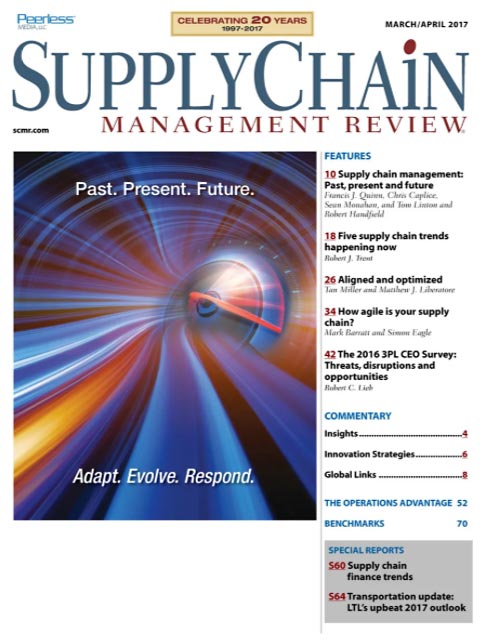Sorry, but your login has failed. Please recheck your login information and resubmit. If your subscription has expired, renew here.
March-April 2017
Supply Chain Management Review, which is celebrating its 20th anniversary with this issue.Twenty years after the premier issue, our goal remains the same: To present thought leadership around best practices in supply chain fundamentals, publish case study examples of what leading companies are doing in their supply chains and keep our finger on the pulse of emerging trends and technologies that will shape the future. While Frank’s essay looks to the past and brings us to the present, we also have essays from four experienced supply chain professionals looking to the future of supply chain management. Browse this issue archive.Need Help? Contact customer service 847-559-7581 More options
Global supply chains have more links than ever, and not all of those links are completely in sync when it comes to payments, cash flow and financing. And while the current economic climate is decidedly more amicable than it was during the Great Recession, that doesn’t necessarily mean buyers are cutting checks any faster (or that suppliers are getting paid any quicker). This reality creates bottlenecks in the supply chain, where even one insolvent or financially unhealthy supplier can interrupt its entire flow.
Enter supplier financing (aka supply chain financing), a concept that was popularized in the mid-2000s, when companies in nearly all industries were struggling to stay afloat. The concept is formally defined as a financing method that allows buyers to lengthen their payment terms to their suppliers while also giving those vendors the opportunity to receive payment earlier (that’s where the “financing” portion—typically provided by a bank or other financing company—comes into play). Through this process, the buyer is able to optimize its own working capital while the supplier generates more cash flow to support its own operations.
Jose Aguayo, product manager for cash flow and payment solutions at UPS Capital, credits increasing globalization and the lengthening of the supply chain with driving demand for supplier financing. “Companies now rely on a complex network of suppliers and buyers that stretch across the globe to manufacture, transport, store and distribute their products,” says Aguayo. “Where once the majority of a company’s capital may have been allocated to properties and facilities, it now goes to working capital (e.g. inventory, receivables, etc.).”

This complete article is available to subscribers only.
Log in now for full access or start your PLUS+ subscription for instant access.
SC
MR
Sorry, but your login has failed. Please recheck your login information and resubmit. If your subscription has expired, renew here.
March-April 2017
Supply Chain Management Review, which is celebrating its 20th anniversary with this issue.Twenty years after the premier issue, our goal remains the same: To present thought leadership around best practices in supply… Browse this issue archive. Access your online digital edition. Download a PDF file of the March-April 2017 issue.Global supply chains have more links than ever, and not all of those links are completely in sync when it comes to payments, cash flow and financing. And while the current economic climate is decidedly more amicable than it was during the Great Recession, that doesn't necessarily mean buyers are cutting checks any faster (or that suppliers are getting paid any quicker). This reality creates bottlenecks in the supply chain, where even one insolvent or financially unhealthy supplier can interrupt its entire flow.
Enter supplier financing (aka supply chain financing), a concept that was popularized in the mid-2000s, when companies in nearly all industries were struggling to stay afloat. The concept is formally defined as a financing method that allows buyers to lengthen their payment terms to their suppliers while also giving those vendors the opportunity to receive payment earlier (that's where the “financing” portion—typically provided by a bank or other financing company—comes into play). Through this process, the buyer is able to optimize its own working capital while the supplier generates more cash flow to support its own operations.
Jose Aguayo, product manager for cash flow and payment solutions at UPS Capital, credits increasing globalization and the lengthening of the supply chain with driving demand for supplier financing. “Companies now rely on a complex network of suppliers and buyers that stretch across the globe to manufacture, transport, store and distribute their products,” says Aguayo. “Where once the majority of a company's capital may have been allocated to properties and facilities, it now goes to working capital (e.g. inventory, receivables, etc.).”
SC
MR


More Finance
- Services sector sees growth in October, reports ISM
- Looking back at NextGen 2024
- Manufacturing again contracts in October, reports ISM
- NextGen Supply Chain Conference set for October 21-23
- Estée Lauder, Schneider Electric and S&S Activewear to receive NextGen End User awards
- 2024 Robotics Application Conference announces session, speaker lineup
- More Finance
Latest Podcast

 Explore
Explore
Business Management News
- Strengthening customer fulfillment: Building a strategic stakeholder network
- The hard job of teaching soft skills
- Trump picks former Wisconsin congressman Sean Duffy for DOT secretary
- Made in Mexico, manufactured by China
- Retail sales see gains in October, reports Commerce and NRF
- Balancing green and speed: Home delivery insights from the pandemic era
- More Business Management
Latest Business Management Resources

Subscribe

Supply Chain Management Review delivers the best industry content.

Editors’ Picks





